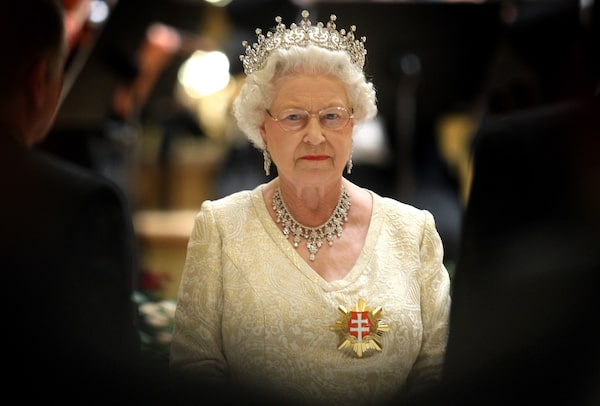
Queen Elizabeth attends a State Banquet at the Philharmonic Hall on the first day of a tour of Slovakia on October 23, 2008 in Bratislava, Slovakia.Chris Jackson/Getty Images
Eleanor Herman’s latest book is Off With Her Head: 3,000 Years of Demonizing Women in Power.
For thousands of years, misogynists have used the same tried-and-true measures to take down powerful individuals suffering from chronic no-penis syndrome. These include attacking a woman’s sex life, body type, clothing, likability, voice, trustworthiness and more – measures rarely, if ever, used to vilify men. And a resounding theme throughout history and mythology is “Blame the woman while we give the man a pass.” (Consider, for a moment, Adam and Eve. Didn’t both of them know God had forbidden them to eat the apple? Why does Eve alone get the blame for all of humanity’s ills while Adam is seen as an innocent victim of his manipulative wife?)
Last week, I was doing a radio interview on this subject, discussing how misogyny sticks to women in the public eye like hot tar, from Cleopatra to Hillary Clinton. Then the host asked, “What about Elizabeth II? Did misogyny impact her as well?”
Now, I am not easily stumped, but that one stopped me in my tracks. Afterward, I mused about the question. Hmmm. Elizabeth II. Misogyny. Sexism. Well, she has been accused of being a distant, cold mother, jetting off for official duties, leaving her young children in the hands of nannies. (The bad mother trope is almost as prevalent as that of the manipulative seductress. And, let’s face it, if Elizabeth had devoted herself solely to her children, she would have been accused of being a bad queen.) But other than that … no, she hasn’t been a widespread target of misogyny. And I am trying to figure out why.
It’s not that Britain, past or present, is lacking in misogyny. Historic figures such as Anne Boleyn and Wallis Warfield Simpson were seen as using their sexual wiles to manipulate compliant royals Henry VIII and Edward VIII.
Margaret Thatcher was criticized for her shrill voice (she ended up taking voice lessons) and scolding, headmistressy ways. The media mused on Theresa May’s mystifying lack of children (selfish, overly ambitious and unloving), her robotic way of speaking (cold and unfeminine), and her showy footwear (too feminine.) The Sun ran the headline “Heel, Boys” over a photo of Ms. May’s stiletto shoe hovering above the tiny heads of male politicians.
The media shoehorned Princess Diana into a variety of female stereotypes, from sweet, shy virgin, to bulimic emotional mess, to a deranged Fatal Attraction character out to wreak revenge on Prince Charles and her former lovers. Her final role is that of saint, canonized by a tragic early death which expunged earlier misbehaviour. After dating Prince William for the better part of a decade, Kate Middleton was dubbed “Waity Katie,” until she finally got that ring on her finger and lassoed her Prince so she could clamp a tiara on her head and live in a palace happily ever after.
But what was it about Elizabeth? How could a woman so recognizable – what with her face on stamps and money – mostly transcend misogyny for 70 years? Is it because of her position? A queen regnant inhabits a perch far above that of queen consort, royal daughter- and granddaughter-in-law, and prime minister. Perhaps history, culture and tradition have hammered into many of us an innate, almost religious reverence for the monarch of the United Kingdom, no matter which individual fills the role.
Part of that reverence must be because Elizabeth was politically neutral. As a hereditary monarch rather than an elected official, she was never required to take a position on taxes, unemployment or inflation; indeed, she saw her role as specifically not doing so. Moreover, because she wielded no actual power, she was no threat to men. There was, quite simply, no reason to lob misogynistic smears at her like hand grenades.
Similarly, her feelings remained a cipher. Not that she was unfeeling (cold and unfeminine). It was clear, for instance, that her children’s divorces and other shenanigans hurt her deeply. She just refused to hemorrhage her victimhood to Oprah (like Meghan Markle) or to an author or BBC reporter (like Diana). She was stoically discreet. Everyone could admire how the Queen kept her royal stiff upper lip zipped. Most of us, bellyaching over our lives on Facebook, probably wished we could do so.
Then there was her appearance. Throughout history, powerful women have been derided for their bodies. They are too fat, too thin, not pretty enough or too pretty (which means they are selfish, vain and probably sexually immoral). The Queen was always attractive in a wholesome way, without the movie star beauty that would have caused envy, lust or sexual speculation. Her clothing was sometimes stately, sometimes stodgy. More recently, she became a Popsicle, wearing brightly coloured matching dresses, coats, and hats in lime, lemon, orange and watermelon. She was a reliably cheerful rainbow in an otherwise grey and scary world. And we loved her for it.
Over the years, Elizabeth transitioned from a young mother to a middle-aged mother to a grandmother, the last a role she played for several decades. Grandmother is the most likable, least threatening of female tropes. Grandmothers are comfortable, reassuring, the backbone of the family. Elizabeth provided that and more. She offered a continuity spanning generations, a limitless grace and a devotion to duty that few individuals have ever achieved regardless of their gender.
Which is why, in a world still grappling with rampant misogyny, the words “God save the King” just sound so wrong.
Keep your Opinions sharp and informed. Get the Opinion newsletter. Sign up today.